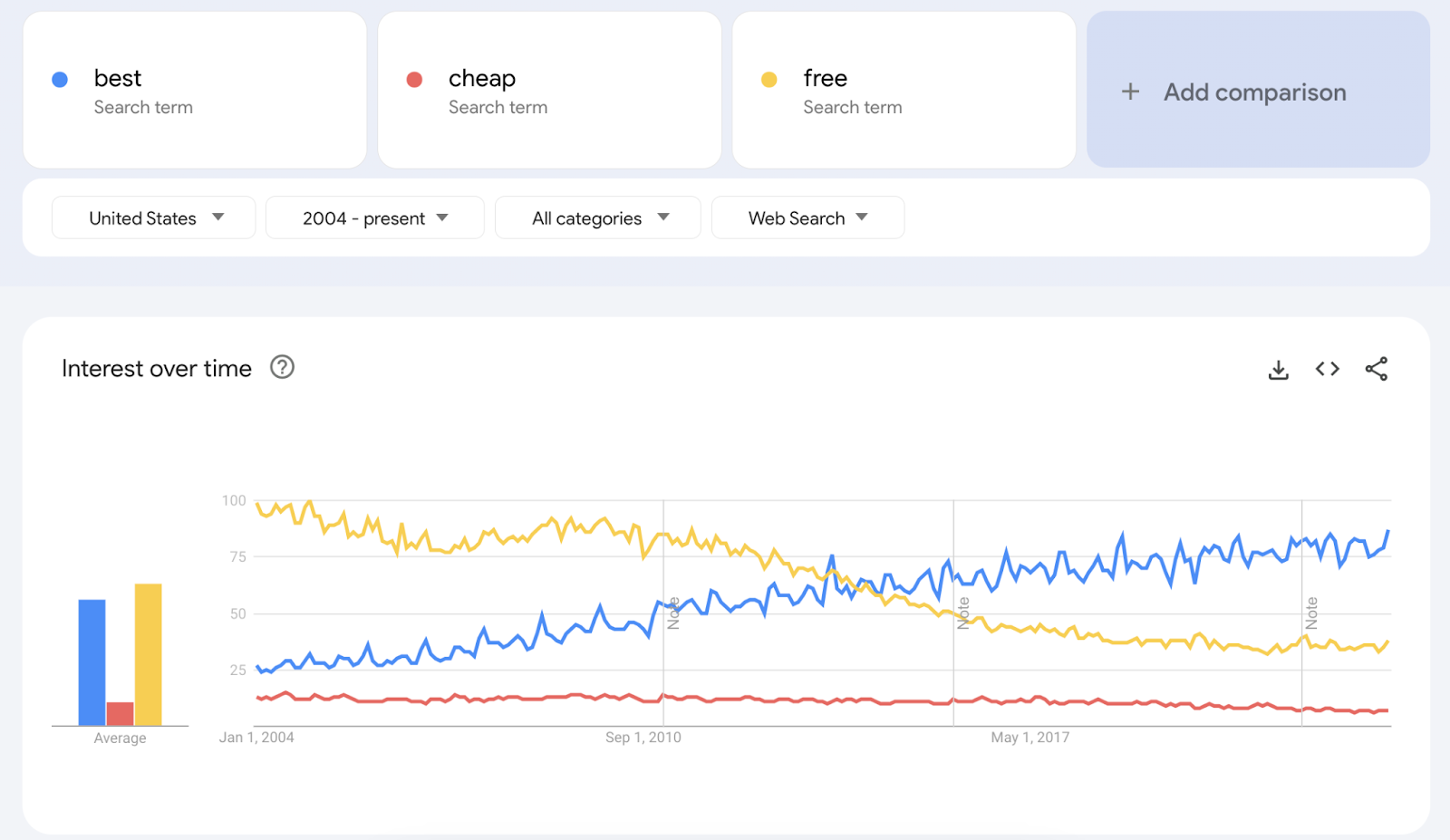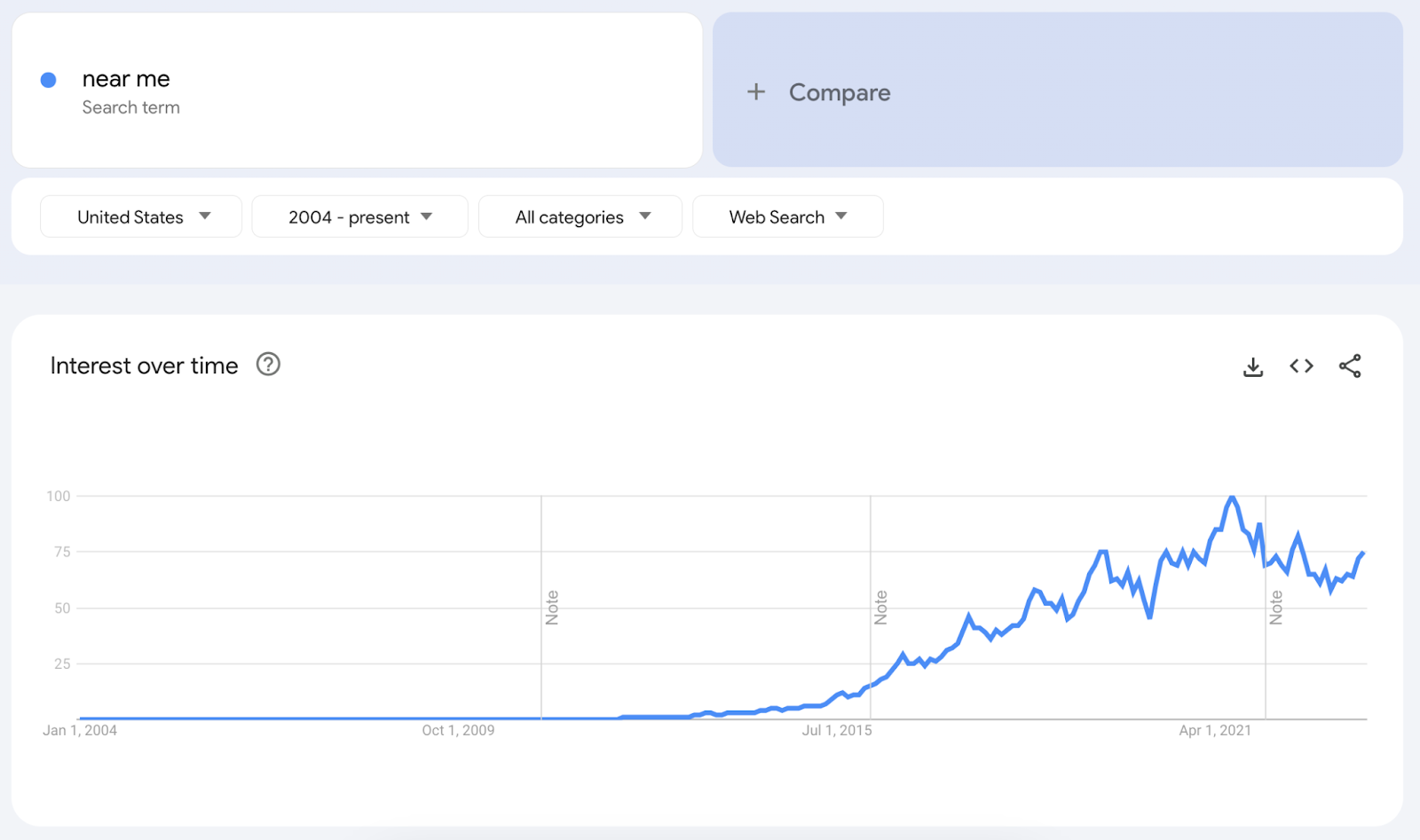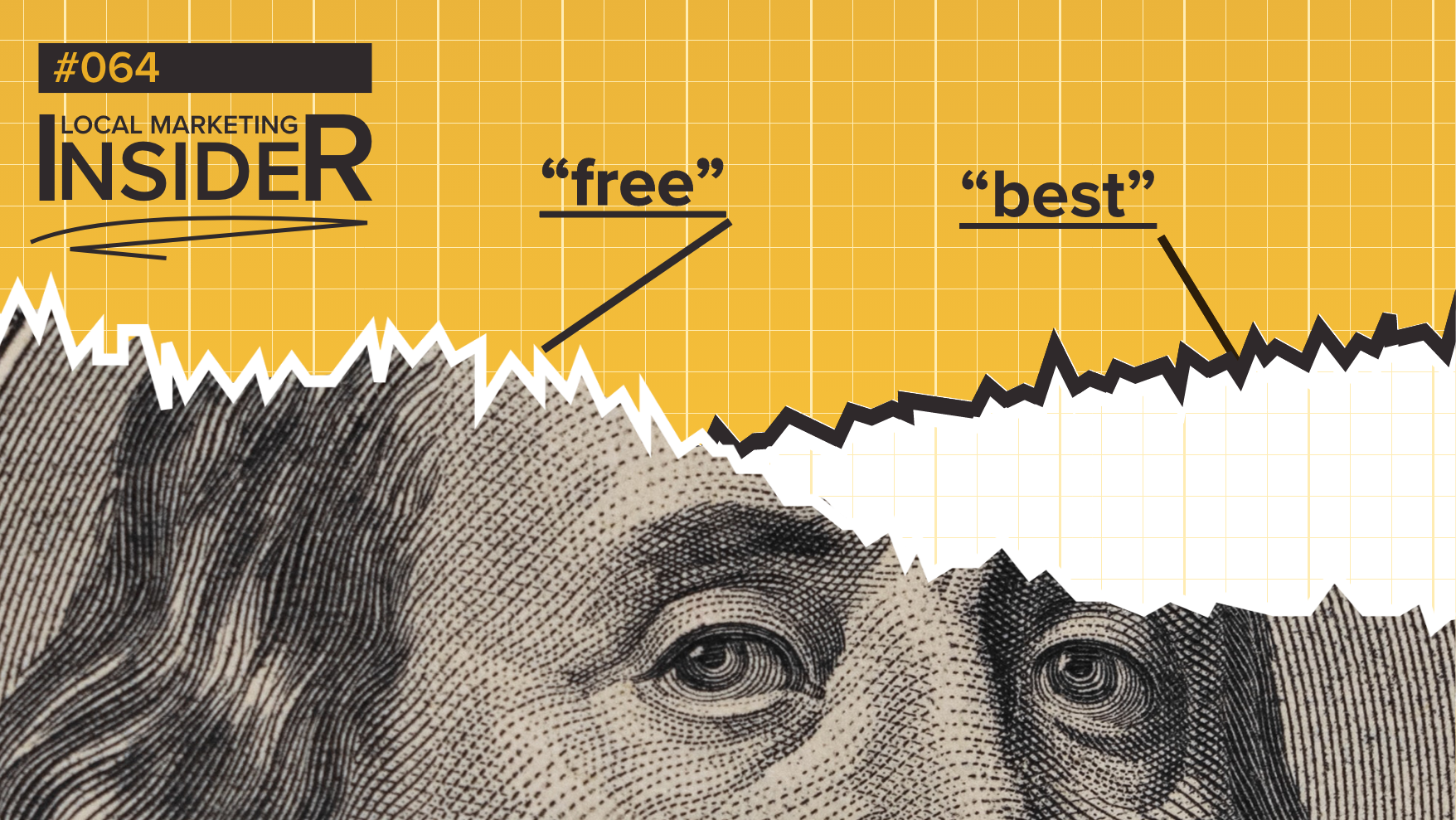Hey! Welcome to Local Marketing Insider where 11,000+ local marketing professionals get better at reputation strategy & more with insights delivered 2x a month.
Read the other articles. Subscribe.
Two years ago, the second-ever LMI I wrote was an article called “Cheap, or Best?”
It’s a personal favorite. Today’s article is the sequel.
Using Google Trends data, I looked at modifiers consumers use in Google searches and how those have evolved over time.
The primary example: “cheap” vs. “best” vs. “free.”

In 2004 “free” dominated search. This was the pre-streaming era. If consumers wanted entertainment online they either bought it or torrented it.

Google Trends shows how the introduction of streaming (Spotify, 2011, Netflix streaming, 2007) effectively erases any consumer desire for free entertainment because, although not free, today $12/month can get you more media than you’d ever need. We’ve collectively agreed this is a great deal.
As access and preferences have changed, “best” has taken over as the preferred modifier.
“Best under” vs. “best cheap” vs. “best affordable”

Consumers don’t necessarily seek out the best. They want the best they can afford.
When we think critically about what “affordable” and “cheap” have in common, what is it?
They’re both subjective measures. Affordable and cheap are relative. What’s affordable to the wealthy is not affordable to the rest of us.
What’s an objective measure of affordability? The almighty dollar.
Instead of “affordable [product/service],” consumers are searching for “best [product/service] under [$price].”
These “best under $X” searches use price anchoring to get closer to the most practical result in fewer steps.
Unsurprisingly, it’s become very popular.
For the marketers reading along, this is a great example of how understanding the ways your consumers evaluate or filter for your products/services can make your marketing significantly more attractive.
For example, instead of pushing for “affordability” messaging, try copy with “best [product/service] under $X” for each of the price points relevant to your business.
Give the people what they want.
“Best apartment” vs. “cheap apartment”
Housing is at the center of our lives and as another example of the case above, we search to find the best we can at a given price point.

The Rise of “Near Me”
Until 2015, “near me” wasn’t used in search.
The rise of local search adoption as a tool to find local businesses is in many ways reflected by the use of this phrase in search queries.
Although it shed 42% of its popularity from its peak heading into 2023, “near me” searches have since regained 15% this spring into summer.

“Apartment near me”
Rising in a similar fashion to “near me,” with “apartment near me,” we can see the clear seasonality of the industry, with interest spiking in the summer and bottoming in the winter.
But, more interestingly, we can see a much flatter 2022 peak, down 15% from an all-time high in 2021, followed by a much deeper drop through the winter of 2023.

If we add “rent prices” to the mix, we can see a spike in price queries corresponding with a slowdown in apartment search popularity, suggesting high prices encouraged renters to stay put.

The Pandemic Recoil
The pandemic popularized services that existed before but had not yet achieved mass adoption. Things like “at-home test drive,” “curbside pickup,” or “remote work.”
Three years later, did any have staying power?
“At home try on”
Primarily related to glasses or high-end clothing, the convenience of the at-home fitting room is here to stay.

“At-home test drive”
Conversely, the convenience of having the car dealership come to the consumer’s home has fallen 96% from pandemic highs. A trip to the dealership remains the norm.

“Curbside pickup”
Down 92% off its high, curbside pickup has either fallen out of fashion or consumers simply know what it is and schedule it directly through retailers rather than searching for options via Google.

“Contactless”
This one surprised me a little bit at first, maintaining 50% of its relevance post-pandemic. The root of it? Contactless payments are here to stay.

“Delivery near me” vs. “restaurant near me”
Going out to eat has come back with force; “restaurant near me” searches hit all-time highs, leaving delivery behind.

“Remote work” vs. “remote jobs” vs. “work from home”

I particularly enjoyed this example because you can see how small nuances in wording capture unique motivators across different groups.
In the 15 years leading up to the pandemic, “work from home” was the common descriptor. “Remote work” was not a part of the public lexicon yet.
We see “remote work” pick up with the pandemic, but relatively modestly. My guess: “remote work” is more of a technical term used by reporters, not something widely useful to most.
Compare that to the rapid ascent of “remote jobs,” which tells a different story. The masses are adopting (or are curious about) a new approach to work and life, hitting all-time highs in 2023.
Just for Fun
“Interest rates” vs. “inflation” vs. “recession”
Both “inflation” and “recession” peaked last year. Despite consistently rising interest rates, we can see clearly that fear or interest around inflation and recession has pulled back significantly as news around the economy has calmed.

“Shortages”
This is a great example of how you can dig deeper and deeper into a topic with features of the Google Trends tool.
I was exploring Google’s Year in Local Search (highly recommend) and came across “shortages” as a highly used word in Glendive, MT which stood out to me.

Searching for “shortages” in trends shows a spike in the last few years.

Looking at the keyword on a regional level, search interest has been focused primarily in the northern Rockies & upper plains states.

Going another level deeper, it turns out the focus is on supplies of food, drugs and water.

Wrapping up
These are all practical examples of the power of Google Trends for marketers.
It can highlight consumer needs, interests and the trending words used to find the right answers.
Give it a shot.
See you in 2 weeks - Jake, Marketing @Widewail









U3GM Blog Post Comments